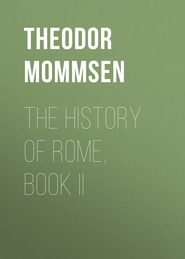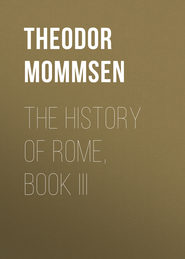По всем вопросам обращайтесь на: info@litportal.ru
(©) 2003-2024.
✖
The History of Rome, Book IV
Настройки чтения
Размер шрифта
Высота строк
Поля
If Quintus Fabius Maximus Eburnus consul in 638 went to Macedonia (C. I. Gr. 1534; Zumpt, Comm. Epigr. ii. 167), he too must have suffered a misfortune there, since Cicero, in Pison. 16, 38, says: -ex (Macedonia) aliquot praetorio imperio, consulari quidem nemo rediit, qui incolumis fuerit, quin triumpharit-; for the triumphal list, which is complete for this epoch, knows only the three Macedonian triumphs of Metellus in 643, of Drusus in 644, and of Minucius in 648.
138
As, according to Frontinus (ii. 43), Velleius and Eutropius, the tribe conquered by Minucius was the Scordisci, it can only be through an error on the part of Florus that he mentions the Hebrus (the Maritza) instead of the Margus (Morava).
139
This annihilation of the Scordisci, while the Maedi and Dardani were admitted to treaty, is reported by Appian (Illyr. 5), and in fact thence forth the Scordisci disappear from this region. If the final subjugation took place in the 32nd year —apo teis proteis es Keltous peiras—, it would seem that this must be understood of a thirty-two years' war between the Romans and the Scordisci, the commencement of which presumably falls not long after the constituting of the province of Macedonia (608) and of which the incidents in arms above recorded, 636-647, are a part. It is obvious from Appian's narrative that the conquest ensued shortly before the outbreak of the Italian civil wars, and so probably at the latest in 663. It falls between 650 and 656, if a triumph followed it, for the triumphal list before and after is complete; it is possible however that for some reason there was no triumph. The victor is not further known; perhaps it was no other than the consul of the year 671; since the latter may well have been late in attaining the consulate in consequence of the Cinnan-Marian troubles.
140
The account that large tracts on the coasts of the North Sea had been torn away by inundations, and that this had occasioned the migration of the Cimbri in a body (Strabo, vii. 293), does not indeed appear to us fabulous, as it seemed to those who recorded it; but whether it was based on tradition or on conjecture, cannot be decided.
141
III. VII. Measures Adopted to Check the Immigrations of the Transalpine Gauls
142
IV. III. Modifications of the Penal Law
143
The usual hypothesis, that the Tougeni and Tigorini had advanced at the same time with the Cimbri into Gaul, cannot be supported by Strabo (vii. 293), and is little in harmony with the separate part acted by the Helvetii. Our traditional accounts of this war are, besides, so fragmentary that, just as in the case of the Samnite wars, a connected historical narration can only lay claim to approximate accuracy.
144
To this, beyond doubt, the fragment of Diodorus (Vat. p. 122) relates.
145
IV. IV. The Proletariate and Equestrian Order under the Restoration
146
The deposition from office of the proconsul Caepio, with which was combined the confiscation of his property (Liv. Ep. 67), was probably pronounced by the assembly of the people immediately after the battle of Arausio (6th October 649). That some time elapsed between the deposition and his proper downfall, is clearly shown by the proposal made in 650, and aimed at Caepio, that deposition from office should involve the forfeiture of a seat in the senate (Asconius in Cornel, p. 78). The fragments of Licinianus (p. 10; -Cn. Manilius ob eandem causam quam et Caepio L. Saturnini rogatione e civitate est cito [?] eiectus-; which clears up the allusion in Cic. de Or. ii. 28, 125) now inform us that a law proposed by Lucius Appuleius Saturninus brought about this catastrophe. This is evidently no other than the Appuleian law as to the -minuta maiestas- of the Roman state (Cic. de Or. ii. 25, 107; 49, 201), or, as its tenor was already formerly explained (ii. p. 143 of the first edition [of the German]), the proposal of Saturninus for the appointment of an extraordinary commission to investigate the treasons that had taken place during the Cimbrian troubles. The commission of inquiry as to the gold of Tolosa (Cic. de N. D. iii. 30, 74) arose in quite a similar way out of the Appuleian law, as the special courts of inquiry—further mentioned in that passage—as to a scandalous bribery of judges out of the Mucian law of 613, as to the occurrences with the Vestals out of the Peducaean law of 641, and as to the Jugurthine war out of the Mamilian law of 644. A comparison of these cases also shows that in such special commissions—different in this respect from the ordinary ones—even punishments affecting life and limb might be and were inflicted. If elsewhere the tribune of the people, Gaius Norbanus, is named as the person who set agoing the proceedings against Caepio and was afterwards brought to trial for doing so (Cic. de Or. ii. 40, 167; 48, 199; 49, 200; Or. Part. 30, 105, et al.), this is not inconsistent with the view given above; for the proposal proceeded as usual from several tribunes of the people (ad Herenn. i. 14, 24; Cic. de Or. ii. 47, 197), and, as Saturninus was already dead when the aristocratic party was in a position to think of retaliation, they fastened on his colleague. As to the period of this second and final condemnation of Caepio, the usual very inconsiderate hypothesis, which places it in 659, ten years after the battle of Arausio, has been already rejected. It rests simply on the fact that Crassus when consul, consequently in 659, spoke in favour of Caepio (Cic. Brut. 44, 162); which, however, he manifestly did not as his advocate, but on the occasion when Norbanus was brought to account by Publius Sulpicius Rufus for his conduct toward Caepio in 659. Formerly the year 650 was assumed for this second accusation; now that we know that it originated from a proposal of Saturninus, we can only hesitate between 651, when he was tribune of the people for the first time (Plutarch, Mar. 14; Oros, v. 17; App. i. 28; Diodor. p. 608, 631), and 654, when he held that office a second time. There are not materials for deciding the point with entire certainty, but the great preponderance of probability is in favour of the former year; partly because it was nearer to the disastrous events in Gaul, partly because in the tolerably full accounts of the second tribunate of Saturninus there is no mention of Quintus Caepio the father and the acts of violence directed against him. The circumstance, that the sums paid back to the treasury in consequence of the verdicts as to the embezzlement of the Tolosan booty were claimed by Saturninus in his second tribunate for his schemes of colonization (De Viris Ill. 73, 5, and thereon Orelli, Ind. Legg. p. 137), is not in itself decisive, and may, moreover, have been easily transferred by mistake from the first African to the second general agrarian law of Saturninus.
The fact that afterwards, when Norbanus was impeached, his impeachment proceeded on the very ground of the law which he had taken part in suggesting, was an ironical incident common in the Roman political procedure of this period (Cic. Brut. 89, 305) and should not mislead us into the belief that the Appuleian law was, like the later Cornelian, a general law of high treason.
147
The view here presented rests in the main on the comparatively trustworthy account in the Epitome of Livy (where we should read -reversi in Gallium in Vellocassis se Teutonis coniunxerunt) and in Obsequens; to the disregard of authorities of lesser weight, which make the Teutones appear by the side of the Cimbri at an earlier date, some of them, such as Appian, Celt. 13, even as early as the battle of Noreia. With these we connect the notices in Caesar (B. G. i. 33; ii. 4, 29); as the invasion of the Roman province and of Italy by the Cimbri can only mean the expedition of 652.
148
It is injudicious to deviate from the traditional account and to transfer the field of battle to Verona: in so doing the fact is overlooked that a whole winter and various movements of troops intervened between the conflicts on the Adige and the decisive engagement, and that Catulus, according to express statement (Plut. Mar. 24), had retreated as far as the right bank of the Po. The statements that the Cimbri were defeated on the Po (Hier. Chron.), and that they were defeated where Stilicho afterwards defeated the Getae, i. e. at Cherasco on the Tanaro, although both inaccurate, point at least to Vercellae much rather than to Verona.
149
IV. IV. The Domain Question under the Restoration
150
I. VI. The Servian Constitution, II. III. Its Composition
151
III. XI. Reforms in the Military Service
152
III. XI. The Nobility in Possession of the Equestrian Centuries
153
IV. IV. Treaty between Rome and Numidia
154
IV. V. Warfare of Prosecutions
155
It is not possible to distinguish exactly what belongs to the first and what to the second tribunate of Saturninus; the more especially, as in both he evidently followed out the same Gracchan tendencies. The African agrarian law is definitely placed by the treatise De Viris Ill. 73, 1 in 651; and this date accords with the termination, which had taken place just shortly before, of the Jugurthine war. The second agrarian law belongs beyond doubt to 654. The treason-law and the corn- law have been only conjecturally placed, the former in 651 (p. 442 note), the latter in 654.
156
All indications point to this conclusion. The elder Quintus Caepio was consul in 648, the younger quaestor in 651 or 654, the former consequently was born about or before 605, the latter about 624 or 627. The fact that the former died without leaving sons (Strabo, iv. 188) is not inconsistent with this view, for the younger Caepio fell in 664, and the elder, who ended his life in exile at Smyrna, may very well have survived him.
157
IV. IV. Treaty between Rome and Numidia
158
IV. V. Warfare of Prosecutions
159
IV. IV. Rival Demagogism of the Senate. The Livian Laws
160
IV. V. And Reach the Danube
161
IV. IV. Administration under the Restoration








